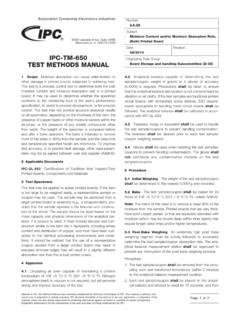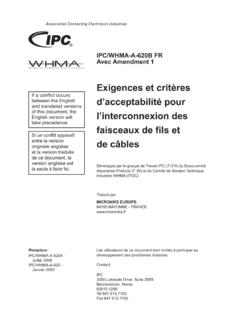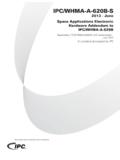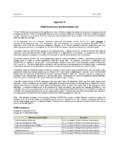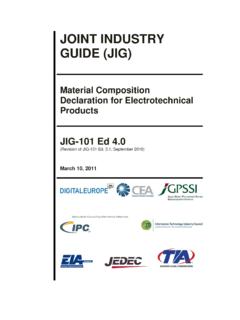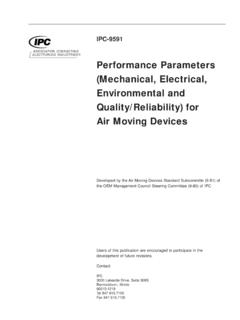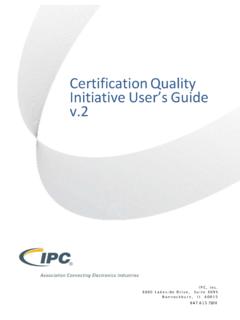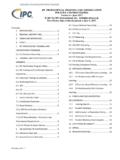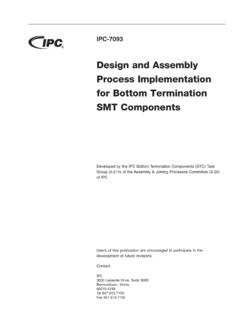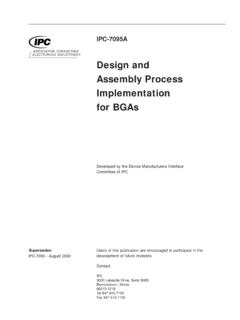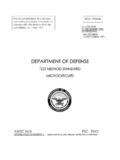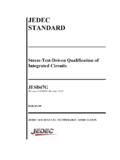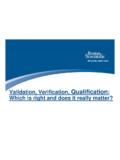Transcription of A standard developed by IPC
1 IPC-CC-830 BAmendment 1 qualification andPerformance of ElectricalInsulating Compound forPrinted Wiring AssembliesSeptember2008A standard developed by IPC Association Connecting Electronics IndustriesThe Principles ofStandardizationIn May 1995 the IPC s Technical Activities Executive Committee (TAEC) adopted Principles ofStandardization as a guiding principle of IPC s standardization : Show relationship to Design for Manufacturability(DFM) and Design for the Environment (DFE) Minimize time to market Contain simple (simplified) language Just include spec information Focus on end product performance Include a feedback system on use andproblems for future improvementStandardsShouldNot: Inhibit innovation Increase time-to-market Keep people out Increase cycle time Tell you how to make something Contain anything that cannotbe defended with dataNoticeIPC standards and Publications are designed to serve the public interest through eliminating mis-understandings between manufacturers and purchasers, facilitating interchangeability and improve-ment of products, and assisting the purchaser in selecting and obtaining with minimum delay theproper product for his particular need.
2 Existence of such standards and Publications shall not inany respect preclude any member or nonmember of IPC from manufacturing or selling productsnot conforming to such standards and Publication, nor shall the existence of such standards andPublications preclude their voluntary use by those other than IPC members, whether the standardis to be used either domestically or standards and Publications are adopted by IPC without regard to whether their adop-tion may involve patents on articles, materials, or processes. By such action, IPC does not assumeany liability to any patent owner, nor do they assume any obligation whatever to parties adoptingthe Recommended standard or Publication. Users are also wholly responsible for protecting them-selves against all claims of liabilities for patent PositionStatement onSpecificationRevision ChangeIt is the position of IPC s Technical Activities Executive Committee that the use and implementationof IPC publications is voluntary and is part of a relationship entered into by customer and an IPC publication is updated and a new revision is published, it is the opinion of the TAEC that the use of the new revision as part of an existing relationship is not automatic unless requiredby the contract.
3 The TAEC recommends the use of the latest October 6, 1998 Why is therea charge forthis document?Your purchase of this document contributes to the ongoing development of new and updated indus-try standards and publications. standards allow manufacturers, customers, and suppliers to under-stand one another better. standards allow manufacturers greater efficiencies when they can setup their processes to meet industry standards , allowing them to offer their customers lower spends hundreds of thousands of dollars annually to support IPC s volunteers in the standardsand publications development process. There are many rounds of drafts sent out for review andthe committees spend hundreds of hours in review and development. IPC s staff attends and par-ticipates in committee activities, typesets and circulates document drafts, and follows all necessaryprocedures to qualify for ANSI s membership dues have been kept low to allow as many companies as possible to , the standards and publications revenue is necessary to complement dues revenue.
4 Theprice schedule offers a 50% discount to IPC members. If your company buys IPC standards andpublications, why not take advantage of this and the many other benefits of IPC membership aswell? For more information on membership in IPC, please visit or call 847 you for your continued support. Copyright 2008. IPC, Bannockburn, Illinois, USA. All rights reserved under both international and Pan-American copyright , scanning or other reproduction of these materials without the prior written consent of the copyright holder is strictly prohibited andconstitutes infringement under the Copyright Law of the United and Performance of Electrical InsulatingCompound for Printed Wiring ClassesReplace as follows:Although previous versions of IPC-CC-830 made referenceto Class A and Class B coating classifications, these classi-fications have been removed.
5 To be qualified to this speci-fication, a coating must be hydrolytically stable (formerlyClass B). Non-hydrolytically stable coatings (formerlyClass A) no longer meet the requirements of this specifica-tion and usage will only be As Agreed Between User andSupplier (AABUS). Coatings that meet the requirements ofClass B coatings in previous document revisions meet therequirements of this :Earlier versions of this specification, as well as otherIPC documents, made reference to Class 1, Class 2, and Class 3 inspection and testing requirements for theseclasses that were not directly correlated to the previousClass A and B IPCD elete the following from theIPC-TM-650 Test Identification of Solder Mask Products UsingFourier Transform Infrared Spectroscopy (FTIR) ANSIC orrect title of NCSL Z540-1 document as follows:NCSL Z540-1 Calibration Laboratories and Measuring andTest Terms and DefinitionsReplace as follows.
6 Definitions of terminology applicable to this standardshallbe in accordance with IPC-T-50 and as stated in AABUSThis is an acronym for As AgreedBetween User and Supplier. Indicates additional or alter-nate requirements to be decided between the user and sup-plier in the procurement documentation. Examples includecontractual requirements, modifications to purchase docu-mentation, and information on the drawing. Agreementscan be used to define test methods, conditions, frequencies,categories or acceptance criteria within a test, if not qualification Inspection and TestingReplace 2ndparagraph as follows:Conformal coatings presently qualified to MIL-I-46058shallalso be recognized as meeting the requirements ofIPC-CC-830. These products currently qualified or in theprocess of being requalified to MIL-I-46058 prior to thepublish date of this document will also be recognized asmeeting the requirements of this document.
7 It should benoted that MIL-I-46058 is inactive for new 3-1 Requirements for qualification , QualificationRetention and Quality Conformance of Conformal Coating ProductsReplace fifth row as follows:ParagraphRequirementTest MethodColumn AColumn BColumn CQualificationRetention Transform InfraredSpectroscopy Test (FTIR)AABUSXXR eplace thirteenth row as follows:ParagraphRequirementTest MethodColumn AColumn BColumn CQualificationRetention and 2008 IPC-CC-830B - Amendment 11 Replace fifteenth row as follows:ParagraphRequirementTest MethodColumn AColumn BColumn CQualificationRetention and HumidityAging (Hydrolytic Stability) the following notes following table 3-1:X Denotes inspection and test required for all classes.* Denotes requirement is different for Class A and Class B. See for Class A and B Shelf LifeReplace the third sentence as follows:Tests to verify shelf lifeshallconsist of Insulation Resis-tance (IR) and Dielectric Withstanding Voltage (DWV).
8 Fourier Transform Infrared Spectroscopy Test(FTIR)Replace first sentence as follows:Fourier Transform Infrared Spectroscopy (FTIR) testshallbe performed AABUS as part of data gathering for theconformal coating during qualification Moisture and Insulation Resistance2ndparagraph, replace as follows:The minimum insulation resistanceshallbe 500 M fortype ER and 5000 M for all other types during humidity,after humidity and one to two hours at reference condi-tions, and after 24 hours at reference Temperature and Humidity Aging (Hydrolytic Sta-bility)Replace as follows:Conformal coating productsshallbe tested in accordancewith IPC-TM-650, Test Method control specimenshallbe maintained at the referenceconditions at 25 5 C [77 9 F] and 50 5% relativehumidity. The aged conformal coatingshallbe tack free no evidence of softening, chalking, blister-ing, surface tack, cracking, loss of adhesion or reversion tothe liquid state.
9 The clarity of the conformal coating mustremain suitable for the viewing of identification markingsand color codes used to identify components over whichthe conformal coating is new subsection as Special RequirementsAny special requirements areAABUS andshallbe noted in the procurement Categories of InspectionChange title of to read as Categories of Inspection and FrequencyAppend subsection as qualification Inspection FrequencyConformalcoating qualification inspectionshallbe performed once oneach conformal coating subsection as qualification Retention InspectionConformalcoating qualification retention inspectionshallbe per-formed once every two years on each conformal coatingproduct in order to prove consistent compliance to theoriginal subsection as Quality Conformance InspectionQuality con-formance inspectionshallbe performed for every batch ofconformal coating product.
10 A batchshallconsist of all con-formal coating materials produced by one continuous identification is required (see ). Frequency of InspectionDelete , , and through as through - Amendment 1 September 20082 Appendix A Example of qualification Inspection ReportDelete the following from the [ ] Pass section of theOverall qualification Results:[ ] Class A Non-hydrolytically Stable Product[ ] Class B Hydrolytically Stable ProductReplace row entitled Fourier Transform Infrared Spectroscopy as follows:TestTest MethodParagraph inIPC-CC-830 BResultsRemarksFourier Transform InfraredSpectroscopy Test (FTIR) to be retained forfuture referenceReplace row entitled Moisture and Insulation Resistance as follows:TestTest MethodParagraph inIPC-CC-830 BResultsRemarksMoisture and [ ] Pass 500 M minimum[ ] Pass 5000 M minimum[ ] FailAppendix B Example of qualification Retention Inspection ReportReplace row entitled Fourier Transform Infrared Spectroscopy as follows:TestTest MethodParagraph inIPC-CC-830 BResultsRemarksFourier Transform InfraredSpectroscopy Test (FTIR) to be comparedwith that from the originalqualification test[ ] Pass[ ] FailReplace row entitled Moisture and Insulation Resistance as follows:TestTest MethodParagraph inIPC-CC-830 BResultsRemarksMoisture and [ ] Pass 500 M minimum[ ] Pass 5000 M minimum[ ] FailSeptember 2008 IPC-CC-830B - Amendment 13
